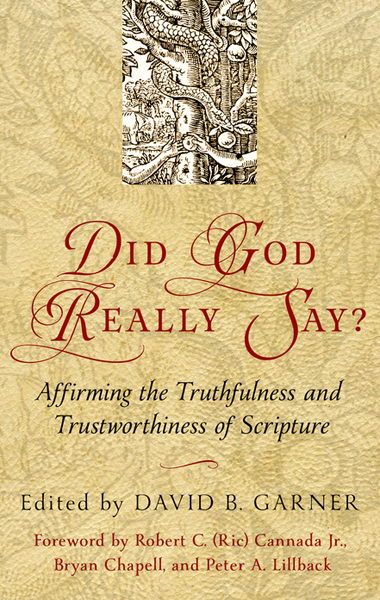
Glorious Symphony
The Westminster Confession of Faith (WCF) paints Scripture’s beauty with its own eloquent verbal strokes: “the heavenliness of the matter, the efficacy of the doctrine, the majesty of the style, the consent of all the parts, the scope of the whole” (WCF 1.5).
In this 33-chapter summation of the teaching of Scripture, the authors of the confession celebrate how the Bible fits together seamlessly, savingly, gloriously. Like an orchestra where each instrument contributes to the whole masterpiece, the books of the Bible harmoniously resound with gospel truth from Genesis to Revelation. God’s message of redemption has always been by grace through faith. In fact, it has always been by grace through faith in his Son, Jesus Christ.
Scripture’s beauty shines in part by its majestic internal gospel coherence—that each of its parts sweetly agrees, and comes devoid of dissonance, of contradiction. Paul’s gospel is Abraham’s gospel. Both share the gospel of God in Christ.
God never changes his mind, his message, or his purpose. To do so would make him less than God. Nor does he offer one means of salvation in the Old Testament and yet another means in the New Testament. To do so would undermine the purpose, necessity, and value of the work of his Son Jesus for sinners.
The Unity of Scripture
Such intra-biblical unity, however, does not draw upon a careless non-contextual reading of Scripture. The unity of Scripture unfolds in a magnificent, sophisticated, historical tapestry. Biblical unity surges from sweet nascent promises to splendorous, jaw-dropping, angel-marveling fulfillment (1 Peter 1:12; Ephesians 3:7–13)!
What of the old covenant sacrifices, the worship, the prophets, priests and kings? What of the Exodus, the Passover, divine guidance in the wilderness, and entry into the Promised Land? What of Enoch, Abraham, Samuel, David, and Deborah? As the Scriptures affirm, these divine “movements” in history combine to produce the symphonic score of the Christ-centered revelation, which starts in the Old Testament and reaches its crescendo in the arrival of the promised Messiah in the New Testament (Luke 24:13–49; John 5:39–47; Hebrews 1:1–2; 3:1–6; 1 Peter 1:10–11).
Biblical unity, therefore, is not merely propositional. The Bible’s self-consistency extends beyond one biblical book’s conceptual compatibility with another. Divine revelation unfolds directly upon stage of history, when and where God masterfully and coherently has built from one age unto the next. God has worked and spoken always in reference to his Son: the coming One and then the One who came. Promised through the prophets, Gods’ work and his word display his Son, because by this Son’s ministry his purpose for human history comes to its own (Ephesians 1:3–14).
To change the metaphor a bit, Old Testament tributaries feed the river of redemptive grace, a river that flows from the sovereign heavenly Font about the Redeemer Son. All biblical streams flow with Christ and toward Christ, converging in a waterfall of grace poured out in his historic arrival and redemptive work. These streams of living water provide spiritual nourishment at each stage of history only because they proclaim the Jesus, the only Savior of sinners.
The Old Testament is not tangential to the work and ministry of Jesus but essential to it. He did not come “to abolish the Law or the Prophets . . . but to fulfill them” (Matthew 5:17). The actual value of the work of Christ in the New Testament is wholly wrapped up with the essential, anticipatory Christological meaning of the prior testament. Or to put it negatively, without the Old Testament, the work of Jesus Christ would lack explanation, understanding, and even significance.
Simply put, Jesus is the substance and center of the Bible. Old and New Testaments carry and convey Jesus! The reason there is a New Testament is because there is an Old. God’s deeds and words in the Old Testament provide the historical and theological foundations for all that he brings about in Christ Jesus.
History and Scripture
Rather than dropping from heaven as an abstract religious manual, Scripture unfolds in history. Like concentric circles, whose expansions overlap completely with the necessarily prior inner rings, biblical revelation builds from its first giving to its final outer ring. Without the Old Testament inner ring, there would be no New Testament outer ring. Biblical revelation develops and telescopes from its incipient forms in the Old Testament to its fullest glory in the New.
Again, the Westminster Confession of Faith (7.6) captures this redemptive-historical flow of biblical theology with pithy eloquence: “Under the gospel [that is, the age of final revelation], when Christ, the substance, was exhibited, the ordinances in which this covenant is dispensed are the preaching of the Word, and the administration of the sacraments of baptism and the Lord's Supper: which, though fewer in number, and administered with more simplicity, and less outward glory, yet, in them, it is held forth in more fullness, evidence and spiritual efficacy, to all nations, both Jews and Gentiles; and is called the new testament. There are not therefore two covenants of grace, differing in substance, but one and the same, under various dispensations.” The historical distinctions share the theological genetics of divine grace.
In his theological masterpiece to the church in Rome, the Apostle Paul profiles the Christ-centeredness of his message by unearthing its theological genetics in the prophetic words of the Old Testament: “Paul, a servant of Christ Jesus, called to be an apostle, set apart for the gospel of God, which he promised beforehand through his prophets in the holy Scriptures, concerning his Son, who was descended from David according to the flesh and was declared to be the Son of God in power according to the Spirit of holiness by his resurrection from the dead, Jesus Christ our Lord” (Romans 1:3-4, emphasis added).
Similarly in Galatians, Paul tethers Christ’s ministry to a biblical message given 2000 years prior: “And the Scripture, foreseeing that God would justify the Gentiles by faith, preached the gospel beforehand to Abraham, saying, ‘In you shall all the nations be blessed’” (Galatians 3:8). The gospel to Abraham beforehand was the divine promise of Jesus to come; the gospel preached by Paul in the first century AD delivered the covenantal promise given two millennia prior to the great father of our faith.
Not only do the apostles recognize the historic roots of the gospel in retrospect, but they must also do so because of the Spirit-given, prophetic gospel in prospect. The Holy Spirit, as Author of Scripture (see 2 Peter 1:19–21), predicted Christ’s life, death, and resurrection in the prophetic writings (cf. 1 Corinthians 15:1–3). In other words, the unifying Christ-centered substance of Scripture moves bi-directionally: from New back to the Old, and from the Old into the New.
So writes Peter, “Concerning this salvation, the prophets who prophesied about the grace that was to be yours searched and inquired carefully, inquiring what person or time the Spirit of Christ in them was indicating when he predicted the sufferings of Christ and the subsequent glories. It was revealed to them that they were serving not themselves but you, in the things that have now been announced to you through those who preached the good news to you by the Holy Spirit sent from heaven, things into which angels long to look” (1 Peter 1:10-12, emphasis added). The Old Testament prophets knew they wrote of Jesus, his sufferings and his glories. Restless for his arrival, they wrote of and rested in the seminal promises of God for the Christ to come.
The New Testament then relies wholly upon God’s revelation to the prophets in days past (Hebrews 1:1–2), and proclaims the incarnate Christ as the very redeeming Son anticipated. Though they prophets did not know when Christ was coming, they knew that he was coming and wrote with confident and conscious anticipation of his redemptive “sufferings” and “subsequent glories.” Biblical revelation comes in history for those in history. The vitality of gospel hope is tied to the concrete gospel work of God in Christ—promised and delivered.
Systematic Theology and Biblical Theology
One, steady theme of divine Christ-effected grace then permeates our Bibles. But that theme of divine grace swells to its consummate manifestation and final efficacy in the completed work of Jesus—anticipated in and depended upon in the Old Testament, arrived and depended upon in the New Testament. This swelling and anticipation, which attain their culmination in the New Testament, provides the stuff of biblical theology: historical, organic, integrated and expanding.
Biblical theology centers on this tributary-to-river, seed-to-oak, inner ring-to-outer ring structure of biblical revelation. In this important historical sense, God’s revelation indeed changes. It does so progressively and fluidly, not incompatibly or schizophrenically. To be sure, the revelation of God given to Moses differs from that given to Paul. But the difference lies not in the teaching about the Christ-centered means of salvation, but in the degree of disclosure associated with the work of God at each particular point of biblical history.
Scripture, its consent of all the parts and its scope of the whole, is thematically seamless. This is why there is systematic theology. The Bible teaches consistently about such doctrines as justification, sanctification, adoption, and glorification. Believers of all ages can and must celebrate these glorious biblical themes. But this thematic unity comes to us in unfolding revelation, starting in the Old Testament and concluding in the New Testament. This unfolding revelation is why there is biblical theology.
For those unfamiliar with the verbal toolbox of biblical and theological studies, “biblical” and “systematic” theology can confuse. A few clarifying words are in order. Use of these categories does not indicate that systematic theology is not biblical or that biblical theology is not systematic (organized and coherent). Rather, biblical theology focuses on the historical character of God’s revelation, given at particular times in authentic places to real people (Hebrews 1:1–2). Systematic theology depends upon biblical theology, because God’s revelation provides the only legitimate basis for doing systematic theology. At the same time, systematic theology, as it depends on biblical theology, also provides the God-given guiderails for faithful biblical theology.
To put it slightly differently, there is biblical theology because God has spoken. There is systematic theology because God has spoken. Biblical theology depends on God’s actual revelation in time; systematic theology depends upon God’s internal consistency and changelessness, just as Scripture teaches. In God’s all-wise providence, he spoke at the right time and said what he determined to say. In God’s infinite and changeless wisdom, he has spoken without retraction or alteration.
Scripture’s sweet “consent of all the parts” and “scope of the whole” compels faithful theological reflection: systematic theology that is faithfully biblical, and biblical theology that is faithfully systematic. God is and God has spoken. Theology in all its forms rests in those essential realities.
What then of salvation? True of Abraham, Moses, David, Elijah, Micah and Zechariah; true of Peter, Paul, and Mary (the biblical ones!); true of all believers of all ages: salvation comes by grace through faith alone in the historical Christ alone. “And there is salvation in no one else, for there is no other name under heaven given among men by which we must be saved” (Acts 4:12). With consenting parts, the whole of Scripture majestically and uniformly pronounces this Christ-effected mediation of sinners.
Systematic theology shows that this is so. Biblical theology shows how.

The Alliance of Confessing Evangelicals is member supported and operates only by your faithful support. Thank you.
















 © Alliance of Confessing Evangelicals
© Alliance of Confessing Evangelicals


